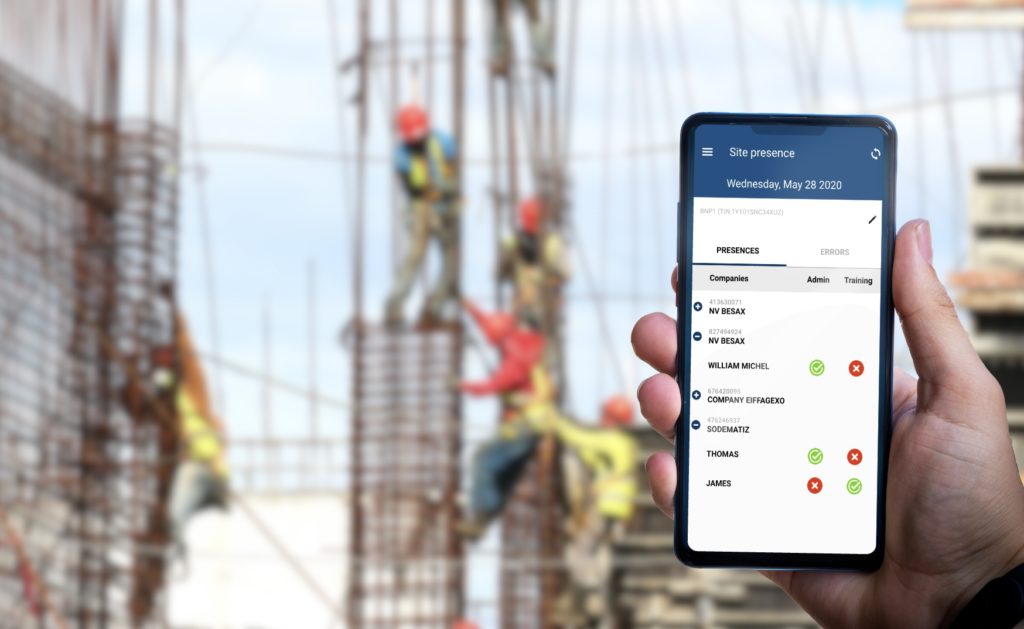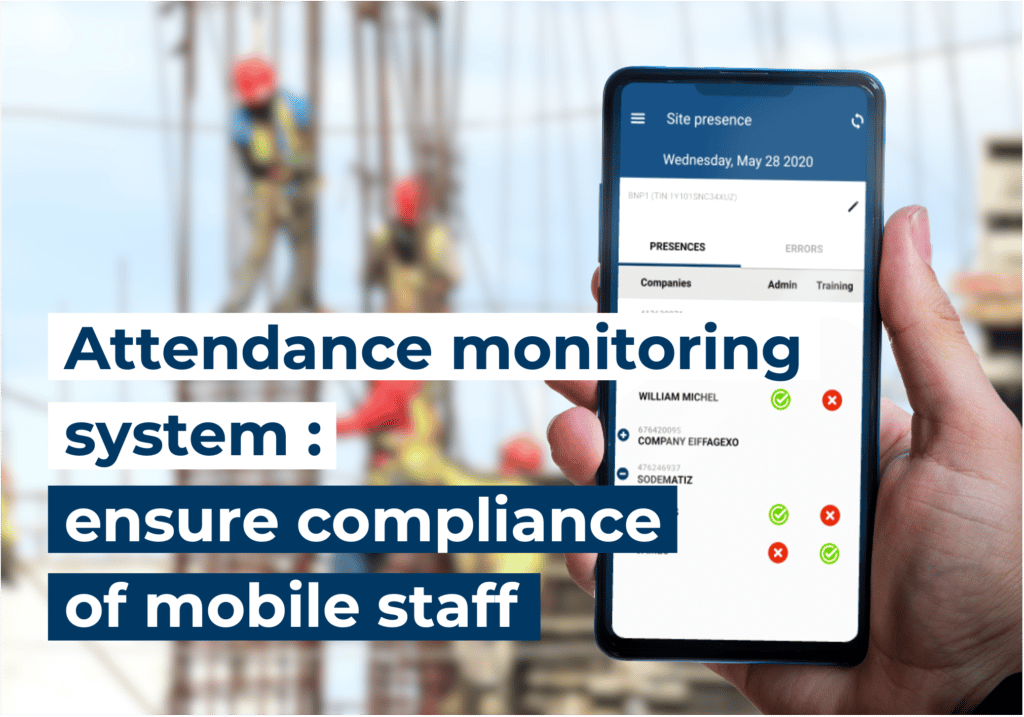
Attendance monitoring enables employees’ hours and locations to be tracked, which is particularly useful in the case of remote workers. Digital solutions provide an overview of all the employees present on a site, at any given time, by recording entry and exit data.
Traxxeo’s Presence Control™, an attendance tracking software solution available as a mobile app, goes further to ensure flawless compliance of your mobile personnel.
Why track your employees’ attendance?
Monitoring employees’ attendance has various purpose. First, it enables you to keep track of your staff motivation and identify any unauthorized absence from work.
However, it’s not just about tracking employees who show up to work late. Attendance monitoring is sometimes a legal obligation: on the construction industry, the control of the presence of workers on the construction site is a legal obligation in more and more countries.
Indeed, the control of the presence plays an important role in the protection of the workers against social dumping and fraud. Besides, digital presence control also play an important role in workers’ safety and security, by preventing accidents on dangerous work sites.
Why is it difficult to track mobile workers’ attendance ?
One of the primary uses of attendance monitoring is to be able to record the entry and exit of workers at their workplace. This has several purposes:
- Track employees’ work time
- Ensure adherence to scheduled hours
- Be able to access the list of staff in attendance at any given moment
These elements together contribute to guaranteeing optimal compliance of staff: no access to sites outside of authorized hours, compliance with legislation relating to employees’ status (permitted working hours, compulsory rest, authorized/unauthorized overtime…), etc.
When employees work in the same place every day on a regular schedule, it is relatively simple to implement an attendance monitoring system. However, when employees work across different sites, or move around during the day, it rapidly becomes more complicated.
Numerous questions quickly come up:
- Who is present on a certain site?
- How many hours have been worked on this or that site?
- Whose administrative status is correct, whose is not?
- How can an incorrect administrative status be addressed?
To respond to these questions, it is necessary to:
- Be able to track the multiple entries/exits of staff on the various sites
- Have access to an overview of the workers present by worksite
- Be able to check the administrative status of each worker arriving on site
- Be able to communicate with head office to induct a new worker and/or regularize their status
It therefore becomes necessary to implement a solution that enables communication between the site and head office. The challenge? Traditional tools and attendance systems do not allow this communication.
How do you monitor employee attendance?
There are several tools traditionally used for attendance control. Here are the four most commonly used, their advantages and disadvantages.
1. Paper timesheets, a limited employee attendance tool
Historically, workers’ attendance was recorded on a sheet of paper, called “attendance sheets”. Often, the hours worked were recorded on this same sheet, so called a “timesheet” or “time card”.
In addition to the time spent recording the information, these methods also require processing time: collecting the various sheets, transferring them to the HR department or reinputting the data into an Excel file, reinputting and processing by HR personnel… Between the time of recording the information and when the data is finally in a usable format, the delay is much too long.
For site workers, it is also very difficult to determine the compliance of the worker in front of them. Often, on a construction site, for example, administrative documents are kept in filing cabinets at the place of work. But what happens when a document is missing or when a new worker starts?
With these methods it is impossible to transfer all the information to head office in a timely manner, without spending hours on the telephone or sending emails.
2. What about clocking-in machines to monitor staff attendance ?
Clocking-in machines, or swipe-card readers, are more and more widely used in companies. Manual clocking-in machine, RFID reader, biometric reader… there are many types.
These solutions have the advantage of enabling tracking of entries and exits of a place of work where they have previously been installed. However, they do also present some disadvantages.
The main limits of traditional clocking-in machines:
- They are fixed and need to be installed on the site in advance. They are not suitable for short-term sites or mobile maintenance work on different sites, for example.
- They only record entries and exits and provide no information about the compliance of the worker who has arrived on site.
- They enable hours to be recorded but not the type of hours worked or any relevant payments or allowances.
When it comes to ensuring the flawless compliance and safety of all mobile workers, clocking-in machines alone are not sufficient.
Still, used with comprehensive attendance tracking software, the time clock system can be a useful channel for accurately recording arrival and departure times. Besides, having an alternative channel to record time, such as a mobile app, will allow you to tailor the attendance tracking process to each situation.
3. Biometrics, is it really a good idea for attendance monitoring ?
Using a biometric device (digital fingerprint reader, facial recognition…) is subject to strict regulation. There is a requirement to prove the necessity for such a device.
In addition, a biometric reader will have the same limits as the other traditional clocking-in methods: used alone, they only allow tracking of entries and/or exits. For sites where there is a need for access to be highly secure, a reliable and comprehensive access control system is required in addition to an attendance tracker.
4. An attendance monitoring system, the best of both world ?
A time clock provides a quick record of attendance, while a paper or Excel timesheet provides more detail. However, neither of these tools allows for two-way communication between the field and the office.
An attendance control system such as Presence Control™ not only offers quick and complete recording, it also allows you to check the administrative status of workers directly from the field.
This system offers great reactivity to any anomaly, ensuring flawless compliance.
How to choose the right attendance monitoring system for mobile staff ?
When choosing an attendance tracking software suitable for your company, there are some key points to take into account. The main question to ask yourself is: “does this attendance management system meet my company’s needs?“.
Those specific needs depend on :
- The company size
- The company industry
- The complexity of your projects
- The number of sites your employees work on in a day
- The number of mobile employees
- Whether you rely on outsourced labor (subcontracting, interim…) or not
Taking into account your specific situation, the attendance monitoring system you choose must be able to respond to the complexity you face when monitoring the attendance of your staff.
Traxxeo’s attendance control system: a fully digital process
1. An attendance tracker app designed for a mobile workforce
Presence Control™ is a mobile app available on smartphones and tablets. The mobile attendance tracking software enables easy attendance management in any location. Its strength is its continuous communication with head office.
On site, employees can record their attendance easily. A manager can check the administrative status of an employee at any time by confirming that there are no missing documents, for example. In the event of an anomaly, the manager is alerted directly and can easily take remedial action (adding the document, excluding the person from site, etc.)
In head office, managers have access to an up-to-date overview of the attendance of the workforce. They can also check in just a few clicks that employees are present and compliant, directly within the attendance tracking software.
The app enables you to check in just a few clicks:
- The attendance of workers on each of the recorded sites.
- The administrative status, meaning all the documents required for a worker are on file and always valid. This can include the accreditations and training required to undertake a certain type of work.
- The right of access to a site, meaning that the worker has not been prohibited access —automatically or manually.
- Safety induction, meaning that when required, the worker has received their safety induction.
The mobile app can work in conjunction with traditional attendance trackers and also provides a virtual clocking-in facility. As a result, the new digital process can easily be adapted to any situation: a long-term site, maintenance work on sites, etc.
2. A document management platform for total control over attendance and compliance
Monitoring the attendance and compliance of remote workers is linked to another issue: managing administrative documents relating to staff. Collecting, checking and sharing these documents takes a significant amount of time and requires great attention to detail when done manually.
The first stage is perhaps the most complex. It involves having to specify all the documents required for a worker to be able to enter a worksite. In the case of construction, for example, there are many different circumstances and requirements.
DocXchange, a document management platform powered by artificial intelligence, will enable you to greatly simplify these processes. The platform establishes for you the list of documents required by type of worker. Thanks to artificial intelligence, it automates the reading, analysis and sharing of your administrative documents.
On a site, for example, the benefits for compliance and safety are considerable. Site managers have access to an up-to-date and comprehensive overview of the profile of each worker. Linked to the attendance monitoring app, DocXchange enables flawless compliance of mobile staff, without impacting on team productivity with long and laborious processes.
With DocXchange platform and Presence Control mobile app, benefit from a complete and flexible attendance tracking software.
A strong attendance monitoring process, a matter of safety and security
Monitoring attendance and ensuring workers’ compliance is a key step in ensuring optimal safety in the workplace. That’s why, in industries like the building sector, attendance monitoring is often mandatory and closely regulated.
If penalties for non-compliance are so severe, it’s because it relates to the safety and security of workers. It is as much about ensuring social security, by avoiding illegal work conditions, as preventing accidents in dangerous workplaces.
To ensure full compliance, a biometric digital fingerprint device is not always necessary or desirable. However, an attendance system with a swipe-card reader is not always sufficient or suitable for a remote workers.
What will make the difference in these cases is having a clear and efficient process. Companies are increasingly implementing digital processes. A reliable digital process that is designed for mobile workers is now available with Traxxeo’s attendance monitoring system.
As they have been developed specifically for them, Traxxeo solutions enjoy widespread uptake by mobile staff. Optimal adoption is vital to ensuring the success of the implementation of a digital process. It is therefore important within the organization that everyone’s roles in the project are well defined, in order to make the transition phase as smooth as possible.
4 key points for effective attendance tracking software
To ensure the optimal compliance, safety and security of mobile employees, the following elements are necessary:
- Meticulous attendance monitoring, undertaken in just a few clicks with Presence Control
- Up-to-date and comprehensive document management, simple with DocXchange
- Tools designed for mobile workers, and fully adopted by them
- Project managers, to lead and ensure the success of the implementation of a digital process
Although optimal compliance alone cannot guarantee the absence of worksite accidents, it undoubtedly contributes significantly to making the work environment a safer place for everyone. The safety and security of employees requires ongoing effort, and every element of it must be carefully and thoroughly implemented.
Ensure flawless compliance of your mobile workforce with Traxxeo
